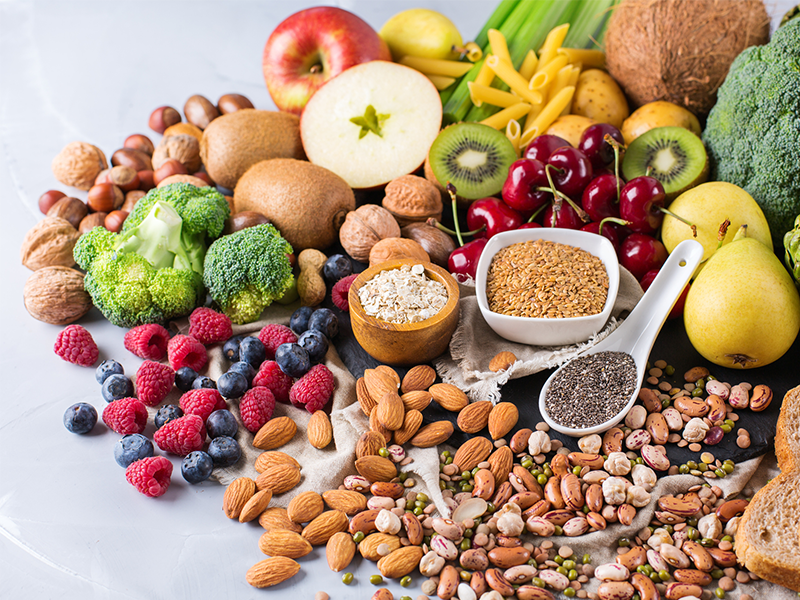What is Fibre?
Dietary fibre is a non-digestible carbohydrate that gives plants their structure.1 Unlike most carbohydrates that are broken down for energy, fibre passes through the digestive tract undigested.
Fibre plays many important roles in the body, from regulating digestion to supporting the gut microbiome.
Most Australians don’t eat enough fibre.2 Research has shown that only 28.2% of adults and 42.3% of children consume the recommended amount of fibre in their daily diets.3 Depending on age, children require 14-22g of dietary fibre daily and adults 25-30g, to experience the health benefits associated with its consumption.4
Not all dietary fibres are equal
Different types of fibre play different roles in the digestive system and feed particular beneficial bacteria. We need all types of fibre in our diets to maintain a thriving digestive system and in turn, optimise our overall health.
Based on their structure and function in our bodies, experts have identified several essential fibre types.5
- Soluble fibre – dissolves in water and helps to slow digestion. It is essential for collecting waste products and eliminating them from the body.
- Insoluble fibre – doesn’t dissolve in water and helps to bulk stool volume. It improves motility and promotes regularity.
- Viscous gel-forming fibre – helps to keep you feeling full for longer and reduce appetite. This form of fibre also aids healthy bowel function and regularity by lubricating the bowel.6
- Prebiotic fibre – encourages pathogen balance so that the “good” bacteria thrive. Prebiotic fibres are the fuel for beneficial bacteria to produce health-promoting metabolites that are essential for many processes in the body including energy production, blood sugar balance, and immune function while supporting overall intestinal health.7
To get all four types of fibre in your diet and help to achieve the recommended daily fibre intake, aim to eat a variety of fibre-rich foods such as whole grains, fruits, vegetables, legumes, nuts, and seeds. However, with busy, modern lifestyles, it can prove challenging through diet alone and supplementing with a quality natural fibre that contains a number of fibre types can help bridge the gap. Adding more fibre to your diet slowly over time can help your body adjust and prevent digestive discomfort.
Sources:
-
Barber, T. M., Kabisch, S., Pfeiffer, A., & Weickert, M. O. (2020). The Health Benefits of Dietary Fibre. Nutrients, 12(10), 3209. https://doi.org/10.3390/nu12103209
-
https://www.betterhealth.vic.gov.au/health/healthyliving/fibre-in-food
-
Fayet-Moore F, Cassettari T, Tuck K, McConnell A, Petocz P. Dietary Fibre Intake in Australia. Paper I: Associations with Demographic, Socio-Economic, and Anthropometric Factors. Nutrients. 2018 May 11;10(5):599. doi: 10.3390/nu10050599. PMID: 29751656; PMCID: PMC5986479.
-
Fibre | Nutrition Australia https://nutritionaustralia.org/fact-sheets/fibre-2/
-
Samuel M. Lancaster, Brittany Lee-McMullen, Charles Wilbur Abbott, Jeniffer V. Quijada, Daniel Hornburg, Heyjun Park, Dalia Perelman, Dylan J. Peterson, Michael Tang, Aaron Robinson, Sara Ahadi, Kévin Contrepois, Chia-Jui Hung, Melanie Ashland, Tracey McLaughlin, Anna Boonyanit, Aaron Horning, Justin L. Sonnenburg, Michael P. Snyder. Global, distinctive, and personal changes in molecular and microbial profiles by specific fibers in humans. Cell Host & Microbe, 2022; DOI: 10.1016/j.chom.2022.03.036
-
Wanders AJ, Mars M, Borgonjen-van den Berg KJ, de Graaf C, Feskens EJ. Satiety and energy intake after single and repeated exposure to gel-forming dietary fiber: post-ingestive effects. Int J Obes (Lond). 2014 Jun;38(6):794-800. doi: 10.1038/ijo.2013.176. Epub 2013 Sep 13. PMID: 24030518.
-
Esgalhado M, Kemp JA, Damasceno NR, Fouque D, Mafra D. Short-chain fatty acids: a link between prebiotics and microbiota in chronic kidney disease. Future Microbiol. 2017 Nov;12:1413-1425. doi: 10.2217/fmb-2017-0059. Epub 2017 Oct 13. PMID: 29027814.

